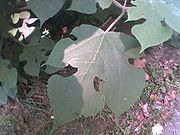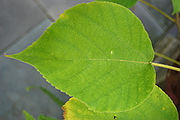
Paper Mulberry
Encyclopedia
The Paper Mulberry is a tree
in the family Moraceae
, native to eastern Asia
. Other names include Dak, Halibun, Kalivon, Kozo, and Tapacloth
tree.
It is a deciduous
tree growing to 15 metres (49.2 ft) tall. The leaves
are variable in shape (even on the same branch), unlobed ovate cordate to deeply lobed, with lobed leaves more frequent on fast-growing young plants; they are 7–20 cm (2.8–7.9 in) long, with a rough surface above, fuzzy-downy below and a finely serrated margin. The male (staminate) flower
s are produced in an oblong inflorescence
, and the female (pistillate) flowers in a globular inflorescence. In summer, the pistillate flower matures into a red to orange, sweet, juicy fruit
3–4 cm (1.2–1.6 in) diameter, which is an important food for wild animals. The fruit is edible and very sweet, but too fragile to be commercialised.
 During the months of February until April proximity to this tree can contribute to severe pollen allergy. In Islamabad, Pakistan the pollen count goes as high as 40000 per m³ causing severe problems for residents.
During the months of February until April proximity to this tree can contribute to severe pollen allergy. In Islamabad, Pakistan the pollen count goes as high as 40000 per m³ causing severe problems for residents.
, Japanese paper and Hanji
.) The tender leaves and twigs can be used to feed deer
, and the tree is sometimes nicknamed the "Deer's Tree".
The paper mulberry tree was brought to the Pacific during the Polynesia
n migrations, and its bark is widely used to make tapa cloth
.

(unofficial).
, where Paper Mulberry was introduced for its scenic value but is now replacing the native flora at an alarming rate. The pollen from this tree is the number-one cause of allergy problems in Islamabad.
Paper Mulberry chokes out native flora because of its very high consumption of water, which leaves less water to sustain the native flora. Because its root system, while extensive, is shallow, it is also prone to being blown down by high winds. When cut, the trees release a latex
-heavy sap which is extremely sticky and can ruin clothing. After cutting, the tree needs to be killed by applying herbicide
to the stump, or the root system will send out multiple coppices which grow quickly from the existing root system. The roots of the tree are aggressive enough to break cinder blocks and cause problems to drainage pipes. The timber is relatively useless, and the strong fibers which make the pulp valuable simply dull saw blades in residential removal.
Tree
A tree is a perennial woody plant. It is most often defined as a woody plant that has many secondary branches supported clear of the ground on a single main stem or trunk with clear apical dominance. A minimum height specification at maturity is cited by some authors, varying from 3 m to...
in the family Moraceae
Moraceae
Moraceae — often called the mulberry family or fig family — are a family of flowering plants comprising about 40 genera and over 1000 species. Most are widespread in tropical and subtropical regions, less so in temperate climates...
, native to eastern Asia
Asia
Asia is the world's largest and most populous continent, located primarily in the eastern and northern hemispheres. It covers 8.7% of the Earth's total surface area and with approximately 3.879 billion people, it hosts 60% of the world's current human population...
. Other names include Dak, Halibun, Kalivon, Kozo, and Tapacloth
Tapa cloth
Tapa cloth is a bark cloth made in the islands of the Pacific Ocean, primarily in Tonga, Samoa and Fiji, but as far afield as Niue, Cook Islands, Futuna, Solomon Islands, Java, New Zealand, Vanuatu, Papua New Guinea and Hawaii...
tree.
It is a deciduous
Deciduous
Deciduous means "falling off at maturity" or "tending to fall off", and is typically used in reference to trees or shrubs that lose their leaves seasonally, and to the shedding of other plant structures such as petals after flowering or fruit when ripe...
tree growing to 15 metres (49.2 ft) tall. The leaves
Leaf
A leaf is an organ of a vascular plant, as defined in botanical terms, and in particular in plant morphology. Foliage is a mass noun that refers to leaves as a feature of plants....
are variable in shape (even on the same branch), unlobed ovate cordate to deeply lobed, with lobed leaves more frequent on fast-growing young plants; they are 7–20 cm (2.8–7.9 in) long, with a rough surface above, fuzzy-downy below and a finely serrated margin. The male (staminate) flower
Flower
A flower, sometimes known as a bloom or blossom, is the reproductive structure found in flowering plants . The biological function of a flower is to effect reproduction, usually by providing a mechanism for the union of sperm with eggs...
s are produced in an oblong inflorescence
Inflorescence
An inflorescence is a group or cluster of flowers arranged on a stem that is composed of a main branch or a complicated arrangement of branches. Strictly, it is the part of the shoot of seed plants where flowers are formed and which is accordingly modified...
, and the female (pistillate) flowers in a globular inflorescence. In summer, the pistillate flower matures into a red to orange, sweet, juicy fruit
Fruit
In broad terms, a fruit is a structure of a plant that contains its seeds.The term has different meanings dependent on context. In non-technical usage, such as food preparation, fruit normally means the fleshy seed-associated structures of certain plants that are sweet and edible in the raw state,...
3–4 cm (1.2–1.6 in) diameter, which is an important food for wild animals. The fruit is edible and very sweet, but too fragile to be commercialised.

Uses
The bark is composed of very strong fibres, and can be used for making high-quality paper. (See: Japanese tissueJapanese tissue
Japanese tissue is a thin, strong paper made from vegetable fibers. Japanese tissue may be made from one of three plants, the kozo plant , the mitsumata shrub and the gampi tree. The long, strong fibers of the kozo plant produce very strong, dimensionally stable papers, and are the most commonly...
, Japanese paper and Hanji
Hanji (Korean paper art)
Korean paper or hanji is the name of traditional handmade paper from Korea. Hanji is made from the inner bark of Paper Mulberry, a tree native to Korea that grows well on its rocky mountainsides, known in Korean as dak. The formation aid crucial to making hanji is the mucilage that oozes from the...
.) The tender leaves and twigs can be used to feed deer
Deer
Deer are the ruminant mammals forming the family Cervidae. Species in the Cervidae family include white-tailed deer, elk, moose, red deer, reindeer, fallow deer, roe deer and chital. Male deer of all species and female reindeer grow and shed new antlers each year...
, and the tree is sometimes nicknamed the "Deer's Tree".
The paper mulberry tree was brought to the Pacific during the Polynesia
Polynesia
Polynesia is a subregion of Oceania, made up of over 1,000 islands scattered over the central and southern Pacific Ocean. The indigenous people who inhabit the islands of Polynesia are termed Polynesians and they share many similar traits including language, culture and beliefs...
n migrations, and its bark is widely used to make tapa cloth
Tapa cloth
Tapa cloth is a bark cloth made in the islands of the Pacific Ocean, primarily in Tonga, Samoa and Fiji, but as far afield as Niue, Cook Islands, Futuna, Solomon Islands, Java, New Zealand, Vanuatu, Papua New Guinea and Hawaii...
.

Cultural reference
Represents the territory tree of the Islamabad Capital TerritoryIslamabad Capital Territory
The Islamabad Capital Territory is one of the two federal territories of Pakistan. It includes Islamabad, the capital city of Pakistan, and covers an area of 1,165.5 km² of which 906 km² is Islamabad proper...
(unofficial).
Invasive species
The fast growing Paper Mulberry when introduced to non-native areas can quickly disrupt the native habitat, becoming a highly invasive species and upsetting the natural ecosystem. This has proven true in many places, including parts of Latin America, the United States, and South Asia, and is particularly conspicuous in the vicinity of the city of IslamabadIslamabad
Islamabad is the capital of Pakistan and the tenth largest city in the country. Located within the Islamabad Capital Territory , the population of the city has grown from 100,000 in 1951 to 1.7 million in 2011...
, where Paper Mulberry was introduced for its scenic value but is now replacing the native flora at an alarming rate. The pollen from this tree is the number-one cause of allergy problems in Islamabad.
Paper Mulberry chokes out native flora because of its very high consumption of water, which leaves less water to sustain the native flora. Because its root system, while extensive, is shallow, it is also prone to being blown down by high winds. When cut, the trees release a latex
Latex
Latex is the stable dispersion of polymer microparticles in an aqueous medium. Latexes may be natural or synthetic.Latex as found in nature is a milky fluid found in 10% of all flowering plants . It is a complex emulsion consisting of proteins, alkaloids, starches, sugars, oils, tannins, resins,...
-heavy sap which is extremely sticky and can ruin clothing. After cutting, the tree needs to be killed by applying herbicide
Herbicide
Herbicides, also commonly known as weedkillers, are pesticides used to kill unwanted plants. Selective herbicides kill specific targets while leaving the desired crop relatively unharmed. Some of these act by interfering with the growth of the weed and are often synthetic "imitations" of plant...
to the stump, or the root system will send out multiple coppices which grow quickly from the existing root system. The roots of the tree are aggressive enough to break cinder blocks and cause problems to drainage pipes. The timber is relatively useless, and the strong fibers which make the pulp valuable simply dull saw blades in residential removal.
External links
- Broussonetia papyrifera
- Broussonetia papyrifera (in Spanish)

